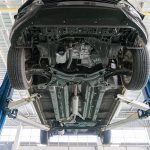1. Introduction to Forced Induction
When it comes to maximizing engine performance, forced induction plays a crucial role. By compressing air before it enters the engine, forced induction systems help generate more power without increasing engine size. Two of the most popular types of forced induction are superchargers and turbochargers. Although they share the same goal—boosting horsepower and torque—they operate in different manners and offer distinct advantages and drawbacks.
What Is Forced Induction?
Forced induction is a method used to increase an engine’s power output by supplying more oxygen to the combustion chamber. Since an internal combustion engine relies on a mixture of air and fuel to generate power, forcing more air into the engine allows it to burn more fuel, producing greater performance.
How Forced Induction Enhances Engine Performance
Unlike naturally aspirated engines, which rely solely on atmospheric pressure to draw air into the cylinders, forced induction systems actively push additional air into the engine. This results in improved performance in several ways:
- Increased Horsepower: More air enables a greater amount of fuel to be burned, leading to higher power output.
- Better Torque: Forced induction systems enhance torque, especially at lower RPMs.
- Improved Efficiency: Some forced induction systems can reduce engine displacement while maintaining performance, leading to better fuel economy.
Superchargers vs. Turbochargers: A Quick Comparison
Both superchargers and turbochargers are forced induction systems, but they differ in how they operate and deliver power. Here’s a quick comparison:
| Feature | Supercharger | Turbocharger |
|---|---|---|
| Power Source | Driven by the engine’s crankshaft | Powered by exhaust gases |
| Power Delivery | Instant boost, no lag | Lag before boost kicks in |
| Efficiency | Consumes engine power | Improves fuel efficiency |
| Complexity & Maintenance | Simple design, easy to maintain | More complex, requires more maintenance |
Understanding how forced induction works is essential in determining which option—supercharger or turbocharger—is the best fit for different driving needs. In the following sections, we’ll dive deeper into how each system functions, their pros and cons, and which one ultimately delivers better performance.
2. How Superchargers Work
A supercharger is a device that forces more air into the engine’s combustion chamber, increasing power output. Unlike a turbocharger, which relies on exhaust gases, a supercharger is driven directly by the engine, typically via a belt connected to the crankshaft. This gives it an immediate response without the delay, or “lag,” that turbochargers sometimes have.
Types of Superchargers
There are three main types of superchargers, each with its own method of increasing engine power:
| Type | How It Works | Pros | Cons |
|---|---|---|---|
| Roots Supercharger | Uses large spinning lobes to push air into the intake manifold. | Instant power, simple design. | Bulky, less efficient at higher RPMs. |
| Twin-Screw Supercharger | Compresses air between two meshing screws before delivering it to the intake. | More efficient than Roots, good mid-range power. | More expensive, complex manufacturing. |
| Centrifugal Supercharger | Uses an impeller like a turbo but is belt-driven. | Lightweight, efficient at high RPMs. | Less power at low RPMs, slower response than Roots or Twin-Screw. |
How Superchargers Improve Performance
Superchargers provide a significant boost in power because they increase the amount of air entering the combustion chamber. More air allows for more fuel combustion, resulting in increased horsepower and torque. Because they are mechanically driven, superchargers provide immediate power gains, making them ideal for applications where throttle response is critical, such as drag racing and muscle cars.
Supercharger vs. Turbocharger: Key Differences
One of the biggest advantages of superchargers over turbochargers is the elimination of turbo lag. Since superchargers are powered by the engine itself, they deliver consistent boosts at all RPM ranges. However, this also means they use engine power to operate, which can slightly reduce overall fuel efficiency.
Impact on Driving Experience
For everyday driving, superchargers make a noticeable difference in acceleration and throttle response. While they may not be as fuel-efficient as turbochargers, their predictable power delivery makes them a popular choice for those seeking a performance-oriented experience without delay.
![]()
3. How Turbochargers Work
A turbocharger is a forced induction system that increases an engines power output by using exhaust gases to drive a turbine, which in turn compresses the intake air. This results in a higher air-to-fuel ratio, allowing for more efficient combustion and greater horsepower.
How a Turbocharger Functions
The turbocharger consists of two main sections: the turbine and the compressor. Exhaust gases from the engine spin the turbine, which is connected via a shaft to the compressor. The compressor then forces more air into the engines intake manifold, increasing the air density for combustion. This process allows for more power output without increasing engine displacement.
Types of Turbochargers
Turbochargers come in different configurations, each with its own strengths and applications. Here are some of the most common types:
| Type | Description | Advantages |
|---|---|---|
| Single Turbo | A basic turbo system with one turbine and one compressor. | Simple design, cost-effective, and good for general performance gains. |
| Twin-Turbo | Uses two turbochargers, either in parallel or sequential setup. | Reduces turbo lag, improves response time, and provides better power distribution. |
| Variable Geometry Turbo (VGT) | Adjusts turbine geometry to optimize airflow across different RPM ranges. | Less turbo lag, more efficiency at various speeds. |
| Electric Turbo | An electrically assisted turbocharger to reduce lag. | Instant boost response and improved efficiency. |
Advantages of Turbochargers in Performance Applications
Turbochargers are widely used in both daily driving and high-performance applications due to several key benefits:
Increased Horsepower
By compressing more air into the engine, a turbocharger allows for a higher fuel-to-air mixture, producing greater power output.
Better Fuel Efficiency
Turbocharged engines can produce more power with a smaller displacement, improving fuel economy compared to larger naturally aspirated engines.
Compact and Lightweight
Unlike superchargers, turbochargers do not require a direct connection to the engine’s crankshaft, making them a more compact and lightweight option.
Enhanced Performance in High Altitudes
Since they force more air into the engine, turbochargers help maintain power levels even in high-altitude conditions where air density is lower.
Overall, turbochargers offer an efficient way to boost an engines performance without significantly increasing its size. However, they do have some drawbacks, such as turbo lag and complexity. In the next section, we’ll compare the real-world performance differences between superchargers and turbochargers.
4. Performance Comparison: Superchargers vs. Turbochargers
Power Delivery
Superchargers provide instant power because they are mechanically driven by the engine. As soon as you hit the gas, the supercharger starts working, delivering a consistent boost throughout the RPM range. On the other hand, turbochargers rely on exhaust gases to spool up, which means they take a moment to build boost. However, once they reach optimal speed, they can generate higher overall boost levels compared to superchargers.
Throttle Response
When it comes to throttle response, superchargers have a clear advantage. Since they engage immediately with engine speed, there is no lag when you press the accelerator. Turbochargers, however, may experience turbo lag, which is a brief delay before the boost kicks in. Modern turbo technology, such as twin-scroll and variable-geometry turbos, has improved response times, but superchargers generally still perform better in this category.
Efficiency
One of the biggest advantages of a turbocharger is efficiency. Because turbochargers use exhaust gases to create boost, they do not require extra engine power to operate. This makes them more fuel-efficient compared to superchargers. Superchargers, being belt-driven, consume a portion of the engine’s power to function, leading to slightly increased fuel consumption. If fuel economy is a concern, turbochargers tend to be the better choice.
Real-World Applications
Superchargers and turbochargers are used in different types of vehicles based on performance needs. Superchargers are commonly found in muscle cars and high-performance sports cars where instant power and throttle response are critical. Turbochargers, on the other hand, are popular in modern sports cars, economy cars, and even diesel trucks because they offer better fuel efficiency and higher power potential.
Comparison Table
| Feature | Supercharger | Turbocharger |
|---|---|---|
| Power Delivery | Instant and consistent | Delayed but stronger at high RPM |
| Throttle Response | No lag, immediate | Possible turbo lag |
| Efficiency | Less fuel-efficient | More fuel-efficient |
| Best Use Case | Muscle cars, high-performance racing | Sporty sedans, fuel-efficient vehicles |
Understanding the differences in performance between superchargers and turbochargers can help you determine which one best suits your driving needs. Superchargers provide better responsiveness and immediate power, while turbochargers offer greater efficiency and higher peak boost. Your decision will ultimately depend on how you prioritize power delivery and fuel economy in real-world conditions.
5. Which One is Best for You?
Choosing between a supercharger and a turbocharger depends on your driving needs and preferences. Each system offers unique advantages and trade-offs, making it important to consider key factors before making a decision.
Factors to Consider
✔ Driving Habits
If you prefer instant power delivery with no lag, a supercharger is a great choice. It provides a direct boost to the engine, making it ideal for muscle cars and aggressive driving. On the other hand, if you enjoy a balance of power and efficiency for highway driving, a turbocharger might be better suited for you.
✔ Fuel Efficiency
Turbochargers are generally more fuel-efficient because they use exhaust gases to generate power. This makes them a popular option for daily drivers who want performance without sacrificing fuel economy. Superchargers, however, rely on engine power, which can lead to higher fuel consumption.
✔ Maintenance and Reliability
Superchargers are mechanically driven, meaning they tend to be more reliable with less complex components. Turbochargers, while efficient, can have more wear and tear due to extreme temperatures and pressure. If long-term reliability is a priority, a supercharger may be the better choice.
✔ Cost and Installation
Both systems come with installation costs, but turbochargers tend to be more expensive due to the need for additional components like intercoolers and wastegates. Superchargers are simpler to install but may require modifications to fit properly.
Comparison Table
| Factor | Supercharger | Turbocharger |
|---|---|---|
| Power Delivery | Instant, No Lag | Slight Delay (Turbo Lag) |
| Fuel Efficiency | Lower Efficiency | Higher Efficiency |
| Maintenance | More Reliable, Less Wear | Higher Wear, More Complex |
| Cost | Lower Installation Cost | Higher Installation Cost |
| Best For | Performance Enthusiasts, Muscle Cars | Fuel-Savvy Drivers, Daily Use |
By understanding these factors, you can choose the option that best fits your driving style and goals. Whether you prioritize raw power or efficiency, both options can significantly enhance your vehicles performance.


